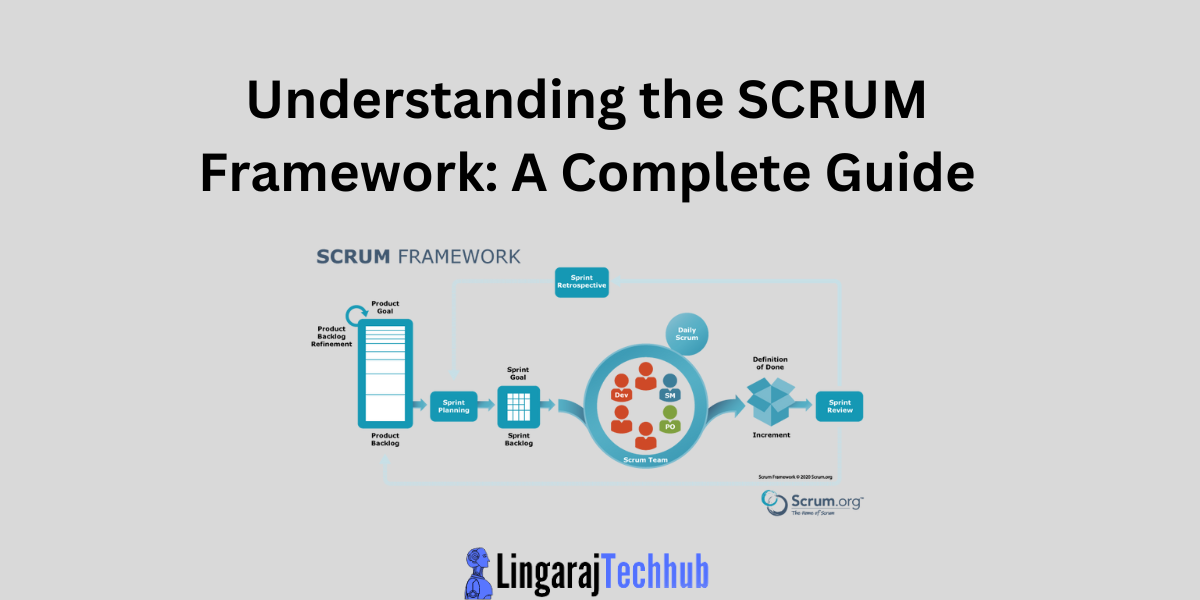Understanding the SCRUM Framework: A Complete Guide
 LingarajTechhub All About Programming
LingarajTechhub All About Programming
Understanding the Scrum Framework
The Scrum framework is a widely adopted methodology within Agile project management, primarily used for developing, delivering, and sustaining complex products. It was initially conceived for software development but has since been applied across various industries. Scrum promotes a flexible, iterative approach that encourages teams to deliver high-value work through collaboration, accountability, and continuous improvement.
Key Components of the Scrum Framework
1. Scrum Team:
Product Owner: The Product Owner is responsible for maximizing the value of the product resulting from the work of the Scrum Team. They manage the Product Backlog, ensuring it is transparent, visible, and understood. They decide on what should be built next based on stakeholder inputs and business needs, prioritizing the backlog accordingly.
- Scrum Master: The Scrum Master serves as a facilitator and coach for the Scrum Team, ensuring they follow Scrum practices effectively. They help the team understand Scrum theory and principles, remove impediments, and foster an environment for high performance. The Scrum Master also works with the organization to enable effective Scrum adoption.
Development Team: The Development Team is a self-organizing and cross-functional group that works together to deliver potentially shippable increments of the product at the end of each Sprint. The team consists of professionals who work collaboratively, share responsibilities, and are accountable for the outcome.
2. Scrum Artifacts:
Product Backlog: The Product Backlog is an ordered list of everything that is known to be needed in the product. It evolves over time as the product and its environment evolve. The Product Owner manages the backlog, ensuring that it is refined and prioritized to meet the team's current focus.
Sprint Backlog: The Sprint Backlog is a subset of the Product Backlog, containing tasks selected for the current Sprint. The Development Team selects items from the Product Backlog, breaking them down into manageable tasks that can be completed within the Sprint duration. The Sprint Backlog is a living document that can be updated during the Sprint as more is learned.
Increment: An Increment is the sum of all Product Backlog items completed during a Sprint and all previous Sprints. It must meet the Scrum Team’s definition of "Done" and be in a usable condition regardless of whether the Product Owner decides to release it.
3. Scrum Events:
Sprint: The heart of Scrum is a Sprint, a time-boxed iteration typically lasting 2-4 weeks. During a Sprint, the Scrum Team works on delivering a potentially shippable product increment. Sprints are continuous, with a new Sprint starting immediately after the previous one ends.
Sprint Planning: Sprint Planning kicks off each Sprint. The Scrum Team collaborates to define the Sprint Goal and determine which Product Backlog items will be worked on. The team also creates the Sprint Backlog during this meeting.
Daily Scrum: A Daily Scrum is a short, time-boxed event (usually 15 minutes) held every day of the Sprint. The Development Team uses it to synchronize activities and create a plan for the next 24 hours. It focuses on what was done, what will be done, and any obstacles faced.
Sprint Review: The Sprint Review is held at the end of the Sprint to inspect the increment and adapt the Product Backlog if needed. The Scrum Team and stakeholders collaborate to discuss what was done in the Sprint, and based on that, they make adjustments to the Product Backlog.
Sprint Retrospective: The Sprint Retrospective is the final event in the Sprint, aimed at continuous improvement. The Scrum Team reflects on the Sprint that just ended, discussing what went well, what could be improved, and how to improve in the next Sprint.
Final Point
The Scrum framework fosters a culture of collaboration, transparency, and continuous improvement, making it ideal for managing complex projects. By focusing on delivering small, iterative improvements, Scrum helps teams respond quickly to changes, deliver high-quality products, and meet customer needs effectively.
Subscribe to my newsletter
Read articles from LingarajTechhub All About Programming directly inside your inbox. Subscribe to the newsletter, and don't miss out.
Written by

LingarajTechhub All About Programming
LingarajTechhub All About Programming
Corporate Software Development Trainer with a demonstrated track record of success in the IT and Ed-tech industries for product development. I started my career as a software developer and have since taught C, C++, Java, and Python to hundreds of IT enthusiasts, including corporate professionals, throughout the years. I have been developing software for over 12 years.